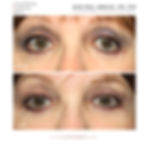Cosmetic Eyelid Surgery Revision: Why you Should Trust your Eyelids to an Oculoplastic Surgeon
- Jean-Paul Abboud, MD, PhD
- Oct 3, 2020
- 3 min read
There is a good number of patients I see in my practice who seek my expertise to revise poor outcomes of previous eyelid surgery and blepharoplasty.
The fact is, complications are an inherent risk of any surgery. Every single surgeon in the world has had surgical complications or undesirable outcomes. A surgeon who claims not to have had a complication is simply not being truthful or has not operated enough to have had one. The risk of developing a surgical complication, however, diminishes with experience and training.
For instance, untoward outcomes in eyelid surgery are exceedingly uncommon in the hands of an experienced and well-trained oculofacial specialist. By the time oculofacial plastic surgeons complete their training, they would have had 3-5 years operating exclusively on the eyelids, the eyes, and the periocular region. In contrast, general plastic surgeons graduate from their training programs having spent an average of one month on eyelid surgery. For details on the difference in oculofacial plastic surgery and general plastic surgery training, check out my blog post on the topic.
Nevertheless, complications can occur even in the most experienced and most trained hands. However, in the rare instance that an undesired result does arise after eyelid surgery, oculofacial plastic surgeons are well-equipped to revise complications - including their own - and to optimize functional and cosmetic outcomes.
The most common complications for which patients see me are:
inability to completely close the eyes (lagophthalmos), caused by aggressive skin excision
poor or inadequate blink, caused by aggressive excision of the orbicularis oculi muscle that is responsible for eyelid blink
pulling down of the lower eyelids (eyelid retraction), caused by aggressive eyelid tissue excision and/or internal scarring
lower eyelids being pulled away from eye (eyelid cicatricial ectropion), caused by aggressive skin excision
sunken/hollow eye appearance, caused by aggressive eyelid fat excision
failure to recognize and address eyelid levator muscle droop/weakness (eyelid ptosis) or brow droop
failure to address prolapsed eyelid fat during blepharoplasty
asymmetry
dry eyes
eye irritation
excessive tearing (epiphora)
unsightly scarring
Less common complications include: loss of vision (due to exuberant bleeding) and double vision (caused by damage to an eye muscle).
Why do complications arise in eyelid surgery? The most common culprit is aggressive surgery, where too much eyelid tissue (skin, fat, muscle) is removed. As such, revision surgery typically requires adding skin and/or tissue grafts to replace the lost tissue.

This lovely lady had an aggressive transcutaneous lower eyelid blepharoplasty (performed through the skin) with another plastic surgeon. This had caused her lower eyelids to become severely retracted (pulled down) with loss of normal eye shape (sad/wide-eyed appearance), loss of confidence, and inability to close her eyes. Notice the “scleral show,” or the white area of the eye showing underneath the pupils in the before pictures.
In this particular case, too much skin and eyelid tissue were excised, ideally requiring a tissue and/or skin graft. However, the patient was reluctant about using a tissue graft to lift the eyelids. With that in mind, I revised the lower eyelid surgery with an incision hidden inside the eyelids (transconjunctival approach), and repaired the eyelid retraction with a midface/cheek lift and a lateral canthoplasty to restore the patient’s nature eye shape and confidence, and to optimize her eyelid closure.


This pleasant young lady had an aggressive transcutaneous lower eyelid blepharoplasty with CO2 laser eyelid skin resurfacing by another plastic surgeon. As the eyelids healed, the lower eyelids started to pull down. This made the eyes appear more rounded and sad looking. Needless to say, she was displeased with the results.
I performed a lateral canthoplasty to restore the youthful almond-shaped eyes and a midface/cheek lift to elevate and suspend the lower eyelids.

While eyelid function and appearance of the eyes can be restored with revision surgery, the key to preventing unsatisfactory results is to seek an oculofacial surgeon specialized in plastic surgery of the eyelids and the periocular region.
In a subsequent blog entry, I will describe my approach to avoiding complications after eyelid surgery. Stay tuned!
For more information about cosmetic eyelid surgery revision or to schedule a consultation, call us at 858.356.2647
These are images of actual patients of Dr. Jean-Paul Abboud. They are shown for informational purposes only and are provided with patient consent for use on this website. Please do not copy or distribute images/videos. Each individual’s treatment and/or results will vary, and no guarantee is stated or implied by any photo or statement used on this website.



